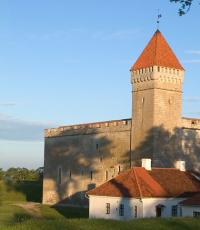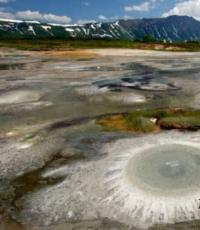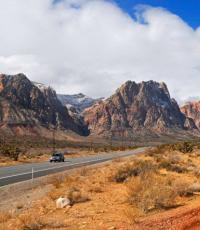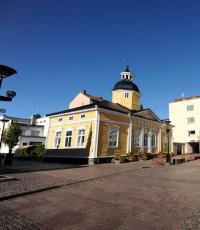Red Rock Canyon State Park in California. Red Rock Canyon - an amazing place near Las Vegas Red Canyon
There are many remarkable places on our planet. The mountains are of particular interest. And if the mountains are multi-colored, then interest grows exponentially. It is these colored mountains that are in the western part of the United States of America in the Mojave Desert. On the east side of the Mountain Springs mountain range, in the southern part of Nevada, near the border with the state of California, is the famous Red Rock Canyon (in the original Red Rock Canyon). The name of this place in translation means Red Mountain Canyon. It is part of the National Park of the same name, covering an area of 792.45 km 2 (195,819 acres). 10 kilometers east of Red Rock Canyon is the outskirts of the legendary casino city of Las Vegas. In good clear weather, the Red Mountains can be seen from the Las Vegas Strip.
Red Rock Canyon on the map
- Geographic coordinates 36.158077, -115.433523
- Distance from the capital of the USA Washington is approximately 3400 km
- The nearest McCarran International Airport (located in the southern part of Las Vegas) is about 26 km
From the name of the canyon, it is quite clear that red color prevails in the mountains. Unusual color combinations of the mountain slopes always arouse the genuine interest of numerous visitors. And in Red Rock Canyon there is something to see. No wonder about 2 million tourists come here every year. Here you can observe amazing overflows of red, orange, yellow and brown colors. Since 1968, this area has been declared a National Park of the same name.
 This is where the national park starts
This is where the national park starts A bit of geology
Cliffs and rocks have formed in these places for millions of years.
During the Paleozoic era, about 600 million years ago, the territory of modern Red Rock Canyon was covered by the ocean. Year after year, limestone was deposited at the bottom. For 350 million years, its thickness was about 3000 meters. In the Mesozoic era (about 250 million years ago), as a result of tectonic movements, the earth's crust in this place began to rise, and more gypsum, salt deposits and iron compounds began to form at the bottom. As the earth's surface rose, iron oxides were cemented with calcium carbonate, creating the most bizarre landscapes that can be seen today. Most of the canyon is made up of sandstone called Aztec.
The red color of some areas of Aztec sandstone is due to the presence of iron oxide or hematite. Exposure to the environment caused iron minerals to oxidize, or "rust," resulting in red, orange, and brown rocks. Areas where the rock can be colored are where the iron has been leached out by subsurface water or where iron oxide has never been deposited. The red spots in the Aztec sandstone are iron-bearing inclusions in which water has deposited iron oxide around a core in the sandstone. These places are more resistant to erosion than the surrounding sandstone, and therefore small balls form here.

Red Rock Canyon today
The protected area features a series of large red rock formations, many sandstone peaks and sheer cliffs called "Keystone Thrust", which can be translated as "Trapezoid Keystones". They seem to cling to each other, forming walls up to 910 m high, which makes them a popular place for hiking and rock climbing. The highest point of this area is Mount La Madre with a height of 2485 meters.
The main one-way ring road, about 21 kilometers long, provides direct access by car to many significant sites in the area. The visitor information center is located at the beginning. The bike path is also very popular for walking. In addition, there are many hiking trails. In total, there are 26 routes on the territory of Red Rock Canyon, different in complexity and length. The length of these paths varies from 240 meters (simple Petroglyph Wall Trail to petroglyphs) to 22.5 kilometers (difficult Bridge Mountain). Below is a diagram of these routes.

For a long time, the Kawaiisu Indians lived in these places, leaving petroglyph drawings on the rocks of the canyon for posterity.

Climate and nature
Red Rock Canyon has quite large temperature differences. In winter, it can drop to -18 o C, and in summer it can rise to +45 o C. The amount of precipitation varies from 2 mm in June to 56 mm in February. But the total rainfall usually does not exceed 300 mm per year.
Despite the fact that the canyon is located in the desert, it cannot be called uninhabited. About 600 species of plants grow here, including coleogyn, juniper, Yucca brevifolia (better known as Joshua tree), Yucca schidigera (also called "Spanish dagger"), agave, which can be twice the height of a person. You can see, so familiar to us, pines.
The life is also varied. Wild donkeys, gophers, rabbits and mice inhabit the area. Occasionally, desert bighorn sheep can be spotted, and during rare spring and summer rains, tiny red-throated toads can be seen in small pools. The territory of the National Park is a protected habitat for the desert tortoise. One of the males of this species named Mojave Max is even the symbol of the Desert Conservation Program.
Now, along with the Arizona Wave and Antelope Canyon, Red Rock Canyon is one of the most interesting colorful natural attractions in the United States.
Schedule
The Visitor Center is open daily from 8:00 am to 4:30 pm.
The time to visit the park depends on the season.
November - February - from 6:00 to 17:00
March - from 6:00 to 19:00
from April to September - from 6:00 to 20:00
from October to 6:00 to 19:00

Red Rock Canyon photo





Red Rock Canyon (Nevada, USA) - exact location, interesting places, inhabitants, routes.
- Tours for the New Year around the world
- Hot tours around the world
Previous photo Next photo
The miracle of nature called Red Rock Canyon is located just 27 km from the miracle of man-made - magnificent Las Vegas. But unlike the US gambling capital, shining with all the lights of the rainbow, this small reserve in the south of the Sierra Nevada has only one color - bright red. It is in it that rocks cut by the wind of bizarre shapes, soaring into the cloudless blue sky, are painted. These Martian-like landscapes attract more than a million tourists every year. However, after wet winters, the cracked earth of Red Rock Canyon is covered with a bright green carpet. The beauty of the desert, coupled with geological and archaeological sites, make the park a center of attraction for campers and Nevada guests who are tired of the noise of Vegas. And here the remains of ancient petroglyphs have been preserved - in such extreme conditions, the life of the Koso Indian tribe once raged.
What to watch
Red Rock Canyon is part of the Mojave Desert, stretching between California, Utah, Arizona, and Nevada. Its sandstone cliffs got their bright red color due to iron oxide, which began to actively form after leaving these places of the ocean. Yes, there was once a sea on the site of this desert territory.
The main feature of the reserve is a 20-kilometer tourist road. Driving along it, visitors get acquainted with the geological history and splendor of the canyon. It is along this path that the most Instagrammable places are located, including the famous Calico Hills, Native American limestone braziers, handprints and pictograms. Another must-see place is the Keystone Thrust. Here, 70 million years ago, two lithospheric plates collided with each other with such force that one of them literally climbed onto the other. The result is a two-layer "pie" of gray limestone and red sandstone.
As a bonus, you can see wild animals - the permanent inhabitants of the park. More than 200 species of mammals live in the reserve, including donkeys, rabbits, coyotes, mustangs, lynxes and cougars. And the most characteristic plants: the Joshua tree, cacti, banana yucca, juniper, Ponderosa pine.
Despite the apparent wildness, gazebos with equipped picnic areas and toilets are scattered throughout the park; observation decks are marked with special signs.
In addition to the endless jagged rocks, the exhibition in the visitor center is also worth a visit. The exhibition area is divided into 4 sectors, symbolizing Earth, Air, Fire and Water. Each of them contains artifacts that tell about all sides of the Red Rock Canyon: history, geography, flora and fauna. And, of course, about people (man appeared here 10 thousand years ago). Also in the center you can take maps with tourist routes - there are only 19 of them. There is a gift shop that sells walking sticks, souvenirs, soft toys and park paraphernalia.
Practical information
Address: 1000 Scenic Loop Drive, Nevada, Las Vegas. Website (in English).
Entrance to the park is free for hikers and cyclists. Entrance for vehicles: car - 15 USD, motorcycle - 10 USD, bicycle - 5 USD. From September to May, camping is open in the park. Prices on the page are for October 2018.
Well, thanks to warm California - Nevada was ahead of us.
The national parks of America (in particular, Nevada and Arizona) are another reason for a mandatory stop in Las Vegas.
Having pretty much climbed on the Internet, having seen enough photos and agreeing on a route in time and place, we decided that moving from Los Angeles to Las Vegas should certainly include an inspection of the Red Rock Canyon.
After a quick breakfast and a load of water and fruit at the supermarket, we tuned our GPS to Vegas. The daughter entered all the route maps into the navigator back in Washington, however, we got lost several times in 6 days, because the Americans build roads all the time, the maps do not keep up with road construction, new interchanges appear, and the GPS arrow sometimes hangs helplessly on the screen, not knowing where to turn. Eh, they don’t steal, you see in America (well, or at least they don’t steal as much as we do :)), that’s why driving on the roads is a thrill! :)
From LA to LV about 4-5 hours. As soon as you leave the city of Angels, civilization practically ends, if you count the wonderful roads, the road signs attached to them and the occasional gas station. This is how you get into the Mojave Desert, the one that seems completely monotonous from the plane. I tried to take pictures directly from the car, because stopping on the track is a waste of precious time. So I apologize for the not very good quality. But I really wanted to convey to you this peculiar beauty of the picture - an unreal blue sky, whose blue is further emphasized by the sand and low mountains.
The Mojave Desert is called the American Sahara. It stretches across 3 states - California, Nevada and Arizona and even captures part of Mexico. In Nevada, tourists usually visit Red Rock Canyon, Valley of Fire and Death Valley. All three are national reserves. We were told that the most cruel of all is Death Valley. In summer (and this is from May to October), the thermometer exceeds the 50-degree mark, flies, for example, are simply afraid to fly so as not to burn their wings - they crawl. A person, losing up to 1 liter of water per hour and not having recharge, can simply die from dehydration.
From Vegas, Death Valley is about 3.5 hours drive and Fire Valley is 2.5 hours.
In fact, you need to set aside a day for each park. Therefore, you need to come to Vegas for at least a week, and "play" here takes the very last place if you want to plunge into the atmosphere of the Wild West. Passing through the desert, you remember American westerns, Indians, saloons, gold rush, everything that you saw from the screen, but it's just next to it...
Red Rock Canyon is only 30-40 minutes from Vegas. Therefore, we decided to end the day there, and then go to a hotel in Vegas.
I don’t know why this place is called a canyon, maybe we didn’t have time to see everything. Red Rock Canyon seemed to me a combination of desert and colorful mountain ranges, with its charm and dissimilarity to any other place. In winter, from November to February, the park is open from 6 am to 5 pm, in March and October it closes by 7 pm, and in summer - the longest period of work - until 8 pm. As in all American parks, entry is paid: from the car - $ 7, but at the same time they give out a route map with the designation of all points and walking routes and a newspaper introducing the flora and fauna of this natural miracle. At the entrance there is a VISITOR CENTER. Near each View Point (point of view) - equipped parking lots and mandatory free toilets, some even adapted for the disabled. A little digressing, I will express my quiet admiration for the democratic approach of the Americans to the so-called Restrooms, and in the common people - "latrines" :). Wherever we are - in museums, parks, memorials, gas stations, railway stations, airports, shopping centers, etc. etc. - toilets are free everywhere, with a full set - paper, soap, towels. Eh, old Europe, why are you peeling 2 euros for the very, very human need! :) Moreover, Ukraine here keeps pace with Europe, unfortunately...
We got to Red Rock Canyon, bypassing Vegas, only hooking it out of the corner of our eye. We arrived an hour before the closing of the park - and saw a stunning sunset. I deliberately do not process these photos and photos of the Grand Canyon (will be in the next review) in Photoshop so that you can see what the American mountains of Nevada look like - interspersed with gray, red, yellow, white. (I don’t know, but for some reason they remind me of halva or sherbet. :)).
How few vegetation clings to life - I could recognize, if I'm not mistaken, only cacti, yucca and some conifers.
"Live" it looks just great! Moving from one point to another (and the roads are asphalt, impeccably smooth, these are not our "goat trails", where the infantry will not pass, and the armored train will not rush :)), we watched the change of colors: the sun was setting, and the illumination of the mountains from bright orange turned into pastel colors - pink, pale purple, golden.
The night fell somehow completely imperceptibly, everything calmed down and calmed down ... And when the mountains merged with the sky, we went to the sparkling lights of Vegas in the distance - the nightlife was just beginning there ...
After spending two days and one night in, we headed towards Las Vegas, but decided to save some money and spend the night at a campsite, a little before reaching the city of sins. And, as it turned out, absolutely not in vain! We spent the night and the next morning in the Red Rock Canyon national conservation area.
There is only one campsite in the Red Rock Canyon and it is located a little further from the very entrance to the reserve. We arrived there just in the evening, so the sun soon set and the temperature was super-comfortable, when you can sit quietly in a T-shirt, looking at the sky, which gradually turns from blue to black with a scattering of stars. By the way, it was there, in the desert, that I saw shooting stars several times. But I didn’t have time to make a wish - it happens too quickly and unexpectedly!
After sunset, the lights of Las Vegas will light up behind that mountain.
A huge plus of camping in Red Rock Canyon, in addition to the warm air at night, was also the complete absence of mosquitoes! To be honest, they don't even exist in California, which is why I keep forgetting to mention it. I remember our student trips - as soon as the sun went down, bloodsuckers immediately begin to attack you, and even at night they buzz under your ear all the time. And here it is warm, good, and no one bites. I would go there again for a week somewhere in the spring or autumn. It turns out a very economical option - to spend the night at a campsite, and go to the sights during the day, because there are so many interesting things around: Las Vegas, the same Red Rock Canyon, Sloane Canyon, Hoover Dam, Valley of Fire, and the Grand Canyon is very close.

In the morning, Sierra woke me up before dawn, so we had time to see how the sun paints the mountains and the desert in orange.
The campsite is located at some distance from the entrance to the Red Rock Canyon Reserve. You can go there at any time of the day or night, but you need to pay within 30 minutes after you have taken a place (the owner of the camping rides on a golf cart and checks). To pay, you need to take an envelope at the entrance, fill in your information (name, campsite number, car numbers and number of nights) and put the envelope with money or a check in a special box.

At the entrance to the Red Rock
General information about camping in Red Rock Canyon
- 72 campsites (of which 5 are for campers)
- The campsite is closed for the summer from the end of May (Memorial day) to the beginning of September (Labor day)
- There are drinking water taps
- Picnic tables
- Special campfire sites
- Canopies from the sun
- There are places for caravans / campers, but there is nothing to connect them to
- No drain station for campers
- Toilet without flush
- Soul no
Individual places
- You can stay for a period of no more than 14 days within a month, in order to give others the opportunity
- No more than 10 people per seat
- No more than 2 cars per seat
- Usually 2 tents can be put up in one place
- Price $15/night per seat
group places
- Total 7 places for groups
- 10-15 people per seat
- No more than 8 cars per place
- Usually 12 tents can be put up in one place
- Price $40/night per seat
- It is not allowed to use the campsite only during the day, at least 10 people must stay overnight
- Required to register upon entry

Amazing colors and textures
What to do in Red Rock Canyon?
- Drive a car/motorcycle/bike on the Red rock canyon scenic drive. This is one of the most popular and easiest ways to see the beauty. Scenic drive is a 13 mile (21 km) loop that can be driven at 35 mph (56 km/h) and much slower in some sections. There are many small parking lots along the road where you can stop and take photos.
- Take a walk/hike. There are more than 20 trails of varying difficulty and length in the Red Rock Canyon
- Find the petroglyphs left on the red rocks by the Indians
- Admire the local flora (Joshua tree, yucca and some shrubs, unique in their root system, extending into the dry land of the desert for 100 meters or more) and fauna (land turtles, rabbits, squirrels, wild donkeys, wild mountain sheep)
- Ride a horse
- Conquer another rock. The canyon is very popular with climbers, for them it’s just a paradise here.
- Wander around the information center where you can learn about the history of the canyon and see what animals live there
So we touched and looked at everything that is exhibited in the information center with pleasure. There I read about a big black wasp with orange wings that we saw many times in Peru. In length, such a wasp (also called "Pepsis" or "Tarantula Hawk") reaches 5 cm, so when it flies by, it seems that it is a helicopter. Even a little uncomfortable. But you should not be afraid of them, because they do not attack people, unless they are provoked. But, if such a wasp stings, then the pain will be terrible. Fortunately, it lasts only about 3 minutes and does not threaten complications.

A wasp that easily wins a fight with a tarantula spider
But the tarantula spiders were less fortunate - it is on them that the female Tarantula hawk hunts. She knows how to lure a spider out of a hole by pulling a web or imitating a female spider, and then easily defeats him in a fight. Sticking a sting into the unprotected place of this huge spider, the wasp paralyzes it, drags it into a hole or digs it into a hole, where it leaves it, having previously laid its egg in its stomach. After that, the wasp larva feeds on the tissues of the tarantula for another month, which remains alive, but paralyzed. In Peru, we saw a couple of times how such a wasp was dragging a half-dead tarantula somewhere.

My young rangers :)
In addition to the information center, we drove along Scenic Drive and headed towards Las Vegas. So, if there is no goal to see everything, go to a hayk or climb a rock, then a couple of hours is enough to inspect the entire reserve, but I would be happy to return there again, just to get to know him better. In general, this time I liked the state of Nevada even more - there are so many natural beauties there that it’s impossible to do everything at once. I’m writing this article and I’m already thinking - “it would be nice to go there for a couple of weeks ...” :).

The rock is really red! Especially, it is amazing in the middle of the gray-beige desert. And for the scale you can see how small people are.

How some fangs stick out!
Safety regulations
I didn't know it myself, but it turns out that every year in Red Rock Canyon, rescuers have to rescue someone with helicopters, search parties and medical assistance. And not just one or two people, but more than 100! Apparently, not everyone believes that this part of the Mojave Desert experiences extreme heat in summer and freezing cold in winter, as well as strong winds, thunderstorms and lightning. So just in case, I will write here about the safety rules.
- Let friends or acquaintances know where you are going and when you should return
- Do not count on mobile communications - here it may not be at all
- Do not leave valuables (bags, passports, camera) in the car, so as not to tempt bad people
- While hiking, be careful - spiders or rattlesnakes can hide under the stones
- Drink plenty of fluids (4 liters per day) and have the same amount in your car per person per day. In the reserve, water is available only in the visitor center
- Be aware of the high air temperature! In summer, limit yourself to short hikes, spend as little time in the sun as possible, and drink plenty of water.
- Choose comfortable (and not new) shoes, long sleeves and trousers
- Don't forget to apply sunscreen
- Avoid the bottom of the canyon when it rains
- Thunderstorms often occur in the summer afternoons. To avoid being struck by lightning, avoid high points, hide in a building or car with closed windows
- Be careful with high cliffs, where you really want to take a beautiful photo - it's easy to slip on the sand or small pebbles. And it’s not at all worth throwing cobblestones from a cliff - the same hikers can go below

In the morning the sun was very bright, so the photo is better taken in the afternoon.

And here the red mountains turn white sharply! As if someone painted them with a huge brush!
Entrance fee to Red Rock Canyon
- One day ticket - $7
- Annual pass valid only for this park - $30
- With an annual pass to US national parks - free. Let me remind you that an annual subscription to US national parks costs $ 80 and it is also valid in national reserves and national monuments.
It is better to go to the Red Rock Canyon Reserve in spring or autumn (), although at other times it will be possible to get acquainted with this beautiful place.




